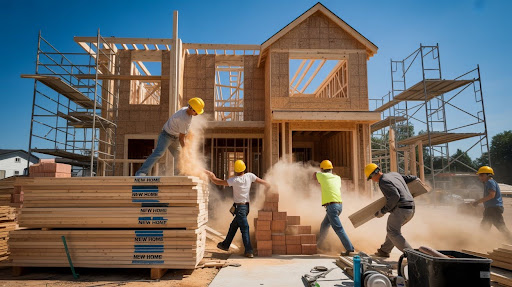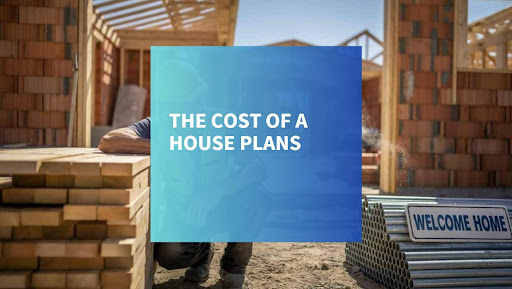Understanding the cost of house plans—including design layout, structural details, and permit-ready drawings—is essential when preparing for a home building project. Architectural service pricing varies based on factors such as the size of the home, level of customization, complexity of the design, and whether the plans are stock or custom. These choices influence not only upfront costs but also affect construction timelines, material needs, and long-term design flexibility.

Builder Types and Their Impact on Plan Costs
The type of builder you choose directly affects how much you should spend on plans and what level of detail you’ll need.
Production Builders ($100-$150 per square foot)
Production builders work with basic plan sets because their business model focuses on efficiency and cost control. A 2,000 – 2,500 square foot house typically costs $300,000-$400,000 with these builders.
At this level, customization is minimal. You might choose between three types of countertops or select crown molding versus carpet, but significant changes are discouraged. The construction quality relies on lower-skilled labor, and design tends to be quick and functional rather than detailed.
Custom Builders ($150-$600 per square foot)
Custom builders represent the widest category, with a 4,000 square foot house costing between $600,000 and $2.4 million. The amount of customization available increases with your price point – the more you spend per square foot, the more freedom you have to make changes.
Construction quality uses mid-level skills, with some overlap in trades between production and custom work. Design quality ranges from basic to good, but rarely reaches the highest levels.
High-End Builders ($500-$2,000+ per square foot)
High-end builders offer unlimited choices and complete customization. Construction uses highly skilled craftsmen who want to challenge themselves with complex details. Design quality ranges from good to exceptional, matching the premium you pay.
Location significantly affects these price ranges – what’s considered high-end in one area might be mid-range in expensive markets like Aspen, Los Angeles, or New York.
How Team Size Affects Plan Requirements
The strength and size of your building team directly impacts how detailed your plans need to be.
Production Building: Minimal Team
With production builders, you essentially have no design team. One person might oversee fifteen houses simultaneously. You may have a salesperson, but there’s no real team focused on your specific project. Plans are basic because the process is standardized.
Custom Building: Small Team Approach
Custom building typically involves:
- A builder
- Possibly a project manager
- Sometimes a designer
- An architect who may have started the plans
This small team provides more attention to your project but still has limitations.
High-End Building: Large Specialized Teams
High-end projects can involve extensive teams:
- Designers with multiple staff members
- Architectural firms with several people managing your project
- Builders with both project managers and superintendents
- Multiple consultants for specialized aspects
Some luxury projects involve dozens of consultants, specialists including 3D rendering designers. This large team of experts allows for more sophisticated execution but may require less detailed plans since the expertise exists within the team.
Geographic Factors That Affect Plan Costs
Your building location significantly impacts how much you should spend on plans.
Rural or Small Town Building
Building in smaller communities often requires more detailed plans because:
- Local lumber yards may have limited high-quality materials
- Access to premium products is restricted
- Local builders typically work at production or lower-end custom levels
- Available skill levels may be limited
In these situations, comprehensive plans with extensive details and specifications become crucial. You need to compensate for a weaker local team with better documentation.
Urban or Sophisticated Markets
Building in areas with skilled contractors allows for simpler plans because:
- Builders understand sophisticated construction techniques
- High-quality materials are readily available
- Craftsmen don’t need extensive direction
- The team has experience with complex details
Projects in these markets might need only half or one-third the documentation required for rural builds.
Three Main Pricing Models for House Plans
Here is some perspective on interiors and architects’ pricing:
1. Cost Per Square Foot
This straightforward approach charges a flat rate based on your home’s size:
Budget Level: $1 per square foot
- A 5,000 sq ft house = $5,000 for plans
- Minimal details and basic documentation
Mid-Range: $5-10 per square foot
- A 5,000 sq ft house = $25,000-$50,000 for plans
- Good detail level with comprehensive documentation
High-End: $10-15 per square foot
- A 5,000 sq ft house = $50,000-$75,000 for plans
- Should include innovative, creative design elements
2. Hourly Fee Structure
Some architects prefer hourly billing, especially when the scope isn’t clearly defined:
Budget Rate: $50 per hour Mid-Range: $200-250 per hour High-End: $300+ per hour
A typical project requiring three months of work (approximately 120 hours) would cost:
- Budget: $6,000
- Mid-range: $24,000-$30,000
- High-end: $36,000+
3. Percentage of Construction Cost
This method ties architectural fees to your overall building budget:
Typical Range: 6-12% of construction cost High-End Projects: Up to 25% (rare, for exceptional projects)
For a $2 million house:
- At 6%: $120,000 for plans
- At 12%: $240,000 for plans
- At 25%: $500,000 for plans
Types of Plan Sets and Their Costs
The Minimum Set
Basic plans might include just three pages:
- All four elevations on one page
- All floor plans on another page
- One page with details and site plan
This approach is essentially “building on a napkin” and rarely produces good results.
The Builder Set (6-20 pages)
About 95% of residential plans fall into this category, including:
- Four elevations
- Floor plans
- Possibly an electrical plan
- Some details
- Roof plan
- Window and door schedule
- Rarely any interior elevations
The Comprehensive Set (18-50+ pages)
Higher-end projects use extensive documentation:
- Detailed floor plans and elevations
- Comprehensive interior elevations
- Extensive detail sheets
- Material specifications
- Structural details
- Landscape integration
Some luxury projects include 100+ pages of documentation.
The Standard Architectural Design Process
Understanding the typical design phases helps you budget appropriately:
Schematic Design
Initial concept development using sketches and rough drawings. This phase establishes the basic layout, room relationships, and overall design direction.
Design Development
Hand drawings are converted to CAD (computer-aided design) for accuracy and reproducibility. Details are refined and systems are coordinated.
Construction Documents
Final detailed drawings with material specifications, allowing contractors to bid accurately and build properly.
Contract Administration (High-End Projects)
Ongoing oversight during construction, including payment reviews, quality checks, and problem-solving.
A Practical Budgeting Rule
A useful guideline is to budget approximately 10% of your construction cost per square foot for plans.
Examples:
- Building at $300/sq ft → Budget $30/sq ft for plans (10%)
- Building at $600/sq ft → Budget $60/sq ft for plans (10%)
For a 3,000 square foot house:
- At $300/sq ft construction cost ($900,000 total) → $30,000 for plans
- At $600/sq ft construction cost ($1.8M total) → $60,000 for plans
When You Need More Detailed Plans
Invest in comprehensive plans when:
- You’re the primary advocate for quality details on your team
- Your builder has limited experience with your desired style
- You’re building in an area with limited skilled craftsmen
- You want to ensure specific architectural details are executed correctly
- Your project includes complex or unusual design elements
When Simpler Plans May Suffice
You might need less documentation if:
- You have an experienced team that understands quality construction
- Your builder specializes in your architectural style
- You’re working with skilled craftsmen who don’t need extensive direction
- Your project uses standard construction methods and details
The Bottom Line
The cost of house plans should align with your project’s complexity, your team’s capabilities, and your quality expectations. While it might be tempting to minimize plan costs, remember that comprehensive documentation is an investment in getting the home you truly want.
Quality plans help ensure that your vision becomes reality, that details are executed correctly, and that your investment in construction delivers lasting value. The right level of documentation for your specific situation will help you avoid costly changes during construction and achieve the results you’re seeking.
Getting Interior Designer or an Architect?
Choosing between an interior designer and an architect is crucial for your project. Architects focus on a building’s structure, functionality, and design, handling blueprints, construction oversight, and code compliance for new buildings or major structural changes. Interior designers concentrate on interior aesthetics, functionality, and safety, addressing space planning, furniture, materials, and creating appealing environments without typically handling structural modifications.
Hire an architect for new construction, significant structural work, legally required blueprints, focus on the building’s form and function, and construction oversight. Hire an interior designer for interior renovations without structural changes, help with space planning, furniture, and materials, enhancing interior aesthetics and comfort, and sourcing furnishings.
Collaboration between architects and interior designers is common and beneficial, especially in new construction or major renovations. Understanding their distinct expertise ensures the right choice for a successful project.
Interiors Considerations
Interior design greatly impacts overall project cost. Details like cabinetry, finishes, flooring, and lighting can significantly alter budgets.
- Cabinetry: Custom cabinetry can be a major expense. Stock or semi-custom options are more budget-friendly but offer less flexibility.
- Finishes and Fixtures: High-end materials like marble, exotic woods, or designer lighting increase costs. Standard materials are more affordable.
- Flooring: Hardwood, tile, and stone are pricier than carpet or laminate. Installation costs also vary widely.
- Interior Details: Moldings, built-ins, and custom features add to the complexity and cost.
Architects’ Pricing in Detail
Architectural pricing reflects expertise and the level of detail provided.
Factors Affecting Architects’ Pricing
- Reputation and Experience: Established architects with a strong portfolio often charge higher fees.
- Project Complexity: Highly customized or complex projects require more design time and documentation, increasing costs.
- Scope of Services: Full architectural services (schematic design through contract administration) cost more than basic plan sets.
- Location: Architects in urban areas or high-cost markets typically have higher fees.
Architects’ Pricing Models
Here is a more detailed look at the pricing models for architectural services:
|
Pricing Model |
Description |
Pros |
Cons |
|---|---|---|---|
|
Cost Per Square Foot |
A flat rate based on the home’s square footage. |
Simple and easy to understand. |
May not accurately reflect the project complexity. |
|
Hourly Fee Structure |
Architects bill for each hour worked. |
Transparent billing, reflects actual time spent. |
Costs can be unpredictable if the project scope changes or takes longer than anticipated. |
|
Percentage of Construction Cost |
A percentage of the overall building budget. |
Ties architectural fees to the project value, ensures alignment of interests. |
Can lead to higher fees if construction costs escalate, may not accurately reflect the architect’s effort. |
Additional Notes on Pricing
- Value of Detailed Plans: More detailed plans minimize surprises during construction, potentially saving money in the long run.
- Negotiation: Architects’ fees can sometimes be negotiated, especially for large or long-term projects.
Clear Contract: A detailed contract outlining services and payment terms is crucial.



























